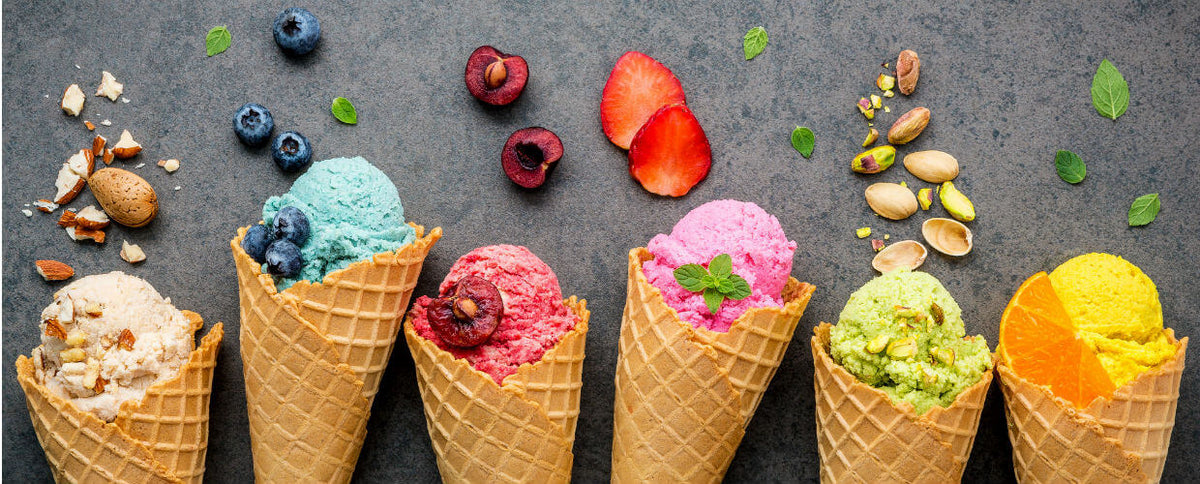8 Things You Need to Know About 'Healthy' Ice Cream

The freezer section is now full of ice cream cartons that boast protein (post-workout reward qualifier?) and have less sugar, less fat, and fewer calories. But is this license to pop a pint more often? We chatted with dietitians to get the scoop on healthy ice cream. Here are eight things to know.
1. Some healthy ice cream contains protein, but not as much as you think.
The labels may boast 20 grams of protein, but that’s usually per pint, explains Jim White, RDN, ACSM EX-P and the owner of Jim White Fitness & Nutrition Studios.
“The American College of Sports Medicine recommends 20 to 30 grams of protein during the recovery period from exercise,” White explains.
"If you’re sticking with the ½ to ⅔ cup serving size (and you should), you’re only taking in between 5 and 7 grams of protein. That’s about as much as a single egg," explains Jill Weisenberger, MS, RDN, CDE, CHWC, FAND and the author of Prediabetes: A Complete Guide, “And the egg is plenty nutritious.”
So treat your ice cream as, well, a treat — not a protein powerhouse.
2. They may not be the type of protein you need.
“Many of these ‘healthier’ ice creams do get their protein from skim milk and eggs, but they also contain milk or plant-based protein concentrate, similar to what’s found in your typical protein bar or shake,” says Katie Hake, RDN. Remember, most of your nutrients should come from whole foods.
3. Be mindful of added sugar.
If you stick with a ½ cup serving, the sugar damage will likely be only 6 grams, lower than many pre-packaged ice cream treats or full-fat ice cream pints. But it’s still added sugar, which research proves doesn’t provide the sustained energy boost of higher quality carbs (like whole grains).
Related: Get Off the Crack: 8 Ways to Cut Sugar From Your Diet
4. The sugar alcohols may not sit well with you.
These high-protein, “lower sugar” healthy ice cream options often contain sugar alcohols, gums, and other fibers. Sugar alcohols have been proven to cause GI distress in some cases, so they may bother your stomach more than eating regular ice cream, particularly if you’re lactose intolerant. Scoop only a smidge to start. “Some people don’t tolerate these added fibers well and should eat only very small amounts until they boost their comfort level,” Weisenberger says.
5. It may not satisfy you as much as full-fat ice cream would.
Thanks to the added fibers and sugar alcohols instead of pure cane sugar, lower-fat, lower-calorie healthy ice cream may not taste as satisfying as a full-fat bowl. This may spur you to eat (a lot) more of it. You may feel more satiated eating a smaller portion of full-fat ice cream or another frozen treat. “One of my favorite frozen dessert portion control tricks is to forgo the ice cream pint and buy items that are pre-portioned like bars and sandwiches,” Weisenberger says.
6. Dairy-free versions may not be much better for you.
You may think that trying a vegan or dairy-free ice cream treat is your healthiest option — and it is, if you’re lactose intolerant or eat vegan. But if you’re not, know that many vegan ice creams are packed with sugar and sugar alcohols. “Some dairy-free versions are similar in total carbohydrates and added sugars. When comparing, be sure to check the serving size on the Nutrition Facts label,” Weisenberger says.
Related: 9 Easy Ways to Eat More Protein Throughout the Day
7. Even if it says “superfood,” stick with the serving size.
What’s the story with pints made with “superfoods,” or sweetened with fruit sugar instead of cane sugar? Some offer a decent amount of protein, like those containing nuts, nut milk — or other non-dairy milk — and seeds. Others, like avocado ice cream, offer healthy fats, but no protein. “Superfood ice creams can be a fun alternative to lighter ice cream, but whichever treat you choose, enjoy it in moderation,” says White.
8. Blending your own is your best bet.
To avoid excess sugar and sugar alcohols (and dairy, if that bothers you), make your own “nice cream,” which usually has a base of frozen bananas. “Fructose can be used as energy and a great source of fuel, especially for athletes, and shouldn’t be feared. In addition to energy, fruit provides antioxidants and other essential vitamins and minerals to help us perform at our best,” Hake says. Blend frozen bananas with peanut butter and a little milk to a thick consistency. Top with dark chocolate chips or walnuts, and dig in. No grocery store run required.
Related: Try This Recipe for Walnut and Nutmeg Ice Cream



